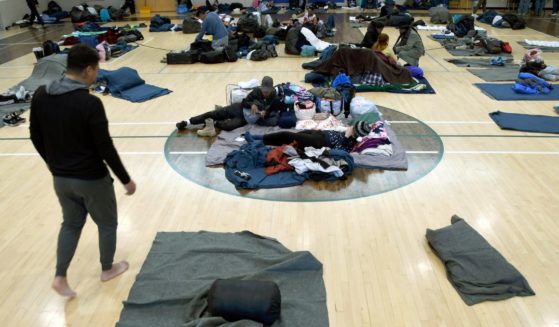Turns Out Cannibalism Isn't as Wiped Out as We Thought
Cannibalism might seem like the stuff of folklore and the primeval days of our ancestors, but in this strange world there are still people who regularly consume human flesh.
The practice has faded as more and more of the world has modernized and previously isolated people groups have established contact with surrounding communities, but cannibalism remains a staple among certain groups even in highly populated and trafficked regions. The reasons vary from tribal warfare, to attempts to gain enlightenment, to defending one’s family from harmful supernatural entities thought to feast on loved ones from the inside out. No matter the reasons, the result is the same – one man’s flesh becomes another man’s food.
Here are the places around the world where that holds true even to this day.
India
The Aghori Sadhus, a sect of Hindu monks, are known to practice cannibalism along the banks of the Ganges river in the city of Varanasi. They do so in worship of the god Shiva the Destroyer and the goddess Kali.
The Aghori do not, however, eat the living. They only eat the flesh of the dead, sometimes from those who donate their bodies to the Aghori after death and also from the unburned parts of bodies from funeral pyres along the riverbank and bodies that have simply been dumped into the Ganges from a ghat, or series of stone steps leading into the river.
The Aghori live near cremation centers, funeral pyres, and body dumping sites for ease of access to human flesh and ash. They bathe daily in the holy river and cover themselves in the ash of cremated human bodies afterward. The Aghori are also known to drink urine from human skulls and to eat excrement.
Why do they engage in such extreme practices while the vast majority of Hindus do not? The beliefs that motivate the Aghori are complex, but in general they reject the duality of the mundane and divine and seek to please Kali by “ripping the veil off reality and jumping straight into the abyss.” They believe that their deities demand more than what most Hindu followers are willing to give, and therefore disregard society’s laws to please their gods and destroy the distinction between what is sacred and what is profane.
“They seek to cultivate a state of consciousness, known as Aghor, in which one transmutes and ultimately transcends base sensations like fear, hatred, disgust or discrimination. On attaining this state one does not view the world in dualistic terms of good and evil, sacred and profane, pure and impure — instead relating to all of manifested reality as attributes of the Great Mother, MA,” wrote Vikram Zutshi of Quartz, who spent time among the Aghori.
The Aghori therefore believe that their cannibalistic practices, the act of covering themselves in human ash, and their secretive sexual rites held among the funeral pyres help them to reject earthly attitudes of duality, embrace death head on in order to break the cycle of reincarnation, and bring themselves closer to Shiva and Kali Ma.
They are also known among locals colloquially as “Crazy Babas.”
Indonesian New Guinea
The Korowai tribe, who live in the jungles far up the Ndeiram Kabur River in Indonesian New Guinea, are also known to practice cannibalism, though their reasons for doing so are far from spiritual enlightenment.
The Korowai believe that the death of their fellow tribe members is sometimes the work of a male witch, or Khakhua, which devours them from within and replaces the insides of their victims little by little with ashes after each nightly feeding until the victim is dead. Before the victim dies, he or she will whisper to a nearby loved one the name of the Khakhua. The family will then capture whoever was named, brutally execute them, dismember the body and eat them. Curiously, the Korowai do not believe this to be cannibalism, as they believe that a Khakhua is entirely inhuman and only assumes the guise of a human – even if they have known and befriended the alleged khakhua for years.
Paul Raffaele described his experience with the Korowai and their accounts to him of killing and eating Khakhuas in a 2006 article for Smithsonian Magazine. Guided by a Sumatran man named Kembaren, Raffaele met a renowned Khakhua-killer among the Korowai named Kilikili, and his brother Bailom. Upon meeting, Bailom handed Raffaele the skull of a recently killed and consumed Khakhua.
“It’s Bunop, the most recent khakhua he killed,” Kembaren said. “Bailom used a stone ax to split the skull open to get at the brains. He was one of my best porters, a cheerful young man.”
Bailom then described how he captured, killed, and ate Bunop after the death of his cousin.
“Just before my cousin died he told me that Bunop was a khakhua and was eating him from the inside,” Bailom told Raffaele. “So we caught him, tied him up and took him to a stream, where we shot arrows into him.”
Bunop reportedly screamed the entire way to the river, claiming desperately that he was not a Khakhua. Bailom paid no heed to Bunop’s cries for mercy.
“My cousin was close to death when he told me and would not lie,” Bailom said.
Bailom used a stone ax to behead Khakhua at the stream, and then and his fellow tribe members chanted and dismembered the body for eating as Bailom held the head aloft.
“We cut out his intestines and broke open the rib cage, chopped off the right arm attached to the right rib cage, the left arm and left rib cage, and then both legs,” Bailom said. The intestines and parts were distributed to the members of the tribe wrapped in banana leaves, but Bailom kept the most prized part of all.
“But I kept the head because it belongs to the family that killed the khakhua. We cook the flesh like we cook pig, placing palm leaves over the wrapped meat together with burning hot river rocks to make steam,” Bailom said.
“Revenge is part of our culture, so when the khakhua eats a person, the people eat the khakhua,” he added. “It’s normal. I don’t feel sad I killed Bunop, even though he was a friend.”
Fiji
The last officially recorded act of cannibalism happened in Fiji in 1867, when Rev. Thomas Baker, a Methodist missionary, made the mistake of touching a chieftain’s head, which was considered a grave insult. The Fijian tribe to whom Baker was attempting to minister then killed, dismembered, cooked, and ate him. According to Fijian legend, the land then became infertile and the peoples of Fiji believed that they had been cursed for killing a Christian missionary. The people of Fiji have made three official apologies to Baker’s descendants, the last one being in 2003. Legend holds that the land became fertile once they apologized to Baker’s descendants.
Rumors persist, however, that some who hold to the traditional ways of Fiji still practice cannibalism in the interior regions of the island where tourists don’t go to honeymoon. An American woman who had lived in Fiji for 20 years recounted to travel writer Tanja M. Laden how an acquaintance of hers, an island native who held to the traditional ways, killed and ate a rival of his after the rival threatened to kill him and eat his entire family in a dispute over a mutual love interest. As cannibals have not historically and do not now normally record their practices, the question of whether cannibalism has truly ceased in Fiji still lingers in light of rumors like this.
According to Rapuga, tribal story-teller of the Mau community in Fiji, Fijians instituted cannibalism as a ritual practice in the 19th century with the arrival of Europeans to their island. They would kill and eat people of other races to protect their land, to absorb their powers, and as a form of revenge. Fijians would use stone axes, spears, eye-gougers, and a weapon for skull crushing to hunt down and eat their foes.
The Fijians would then drink the blood of their enemy to absorb his power, while the chieftain would eat the heart and the brain to absorb the enemy’s courage and knowledge. A tribal priest would then perform a ceremony to one of the gods while the tribe danced and sang around the cooking fire with their spears under the moonlight.
Bonus Round
The above countries are by no means an exhaustive list of the places where cannibalism is practiced, though they are places where the practice is based to some degree on tradition as opposed to desperation, as in North Korea, or simply the escalation of conflict, as was reported in the Democratic Republic of Congo in 2003. Cannibalism has also reared its ugly head in isolated incidents, such as in Germany when Armin Meiwes ate a willing volunteer, Bernd Brandes, after the two dined on Brandes’ genitals. Liberia also saw its fair share of dark, cannibalistic practices during its civil war in the 1990s, when warlords would sacrifice children and drink their blood before going into battle.
In any case, whether cannibalism is motivated by revenge, warfare, or spiritual enlightenment, it is not generally a sign of a thriving and prosperous community.
A version of this article appeared on The Daily Caller News Foundation website. Content created by The Daily Caller News Foundation is available without charge to any eligible news publisher that can provide a large audience. For licensing opportunities of our original content, please contact licensing@dailycallernewsfoundation.org.
Truth and Accuracy
We are committed to truth and accuracy in all of our journalism. Read our editorial standards.












